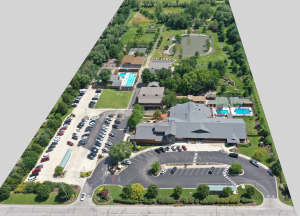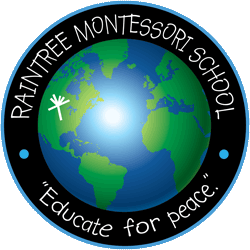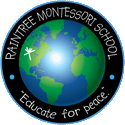Raintree FAQs

What is the Legend of the Raintree?
…a tree whose fruit is love, whose flower is self-fulfillment, whose ways are ways of pleasantness and whose paths all lead to peace. Luck, happiness, the realization of dreams, the secret of Life itself all belong to the one who finds the Raintree.
“A child works to create the man he will become. An adult works to perfect the environment, but a child works to perfect himself.”
-Maria Montessori

What is Raintree?
Founded in 1978 in a vacant church building surrounded by green fields and grazing cattle, Raintree is a private school which implements the Montessori philosophy of education. Raintree offers full-day and half-day options for children ages 3-6 years. In 1986 a full-day toddler class was added for children 18 months to age 3. And in 2012 two additional toddler communities were created. In 1992 Raintree expanded its program to included the elementary child, and now offers an ungraded Montessori elementary program for children ages 6-12. In 2014 we added an adolescent program for children 12-14 years of age.
In addition to the regular program, Raintree offers a summer camp for both Raintree students and those in Lawrence and surrounding communities.
Where is Raintree?
Raintree is located at 4601 Clinton Parkway on thirteen acres with five swimming pools, an outdoor amphitheater, mile-long running path, fishing pond, playgrounds, and gardens.
At what age should my child begin?
The best time for a child to begin attending a Montessori school is around three years of age. The learning that takes place in a Montessori classroom is a cumulative experience, one year building on the skills learned in the previous one. Young children go through stages as they develop called “sensitive periods” in which they are able to learn a new skill almost effortlessly. The acquisition of language is an example of this. The sensitivity is transitory, however, and once gone, never returns. From that point on in a child’s development, he must learn because he is motivated to do so. Therefore, priority is given on our waiting list to children who are younger than four and a half years of age.
What about Raintree’s waiting list?
For parents seeking to enroll their toddler or preschool-age child, the procedure is as follows: children are placed in the waiting list as soon as an enrollment application and registration fee arrives in the office. The child’s name, birth date, program selection and date of application are recorded on the list. The name is highlighted if a child has a sibling presently enrolled in the program because priority is given to siblings. Each semester the names of those children who are old enough to attend are circled. As soon as a space is available parents are called. Please understand that while our confirmations are done on a first-come, first-served basis, we also strive for balanced communities so we pay attention to the ratio of girls/boys and ages of children. Children never lose their placement on the list unless parents withdraw their child’s name, and then re-enroll. Raintree is very careful in this process to be fair to every family. Please keep in mind that if your child’s name reaches the top of the list, it may not stay there for the next term. Two factors can quickly alter that placement: sibling priority and children who are now eligible to attend who enrolled before your child. Children who are presently attending Raintree always have priority over a child not yet attending so a shift from half-day to full-day is possible. We keep an “in house” waiting list for this purpose. After a child has been in our primary program, many parents want their child to attend our elementary program. For information about enrolling in the elementary program, parents should contact the office.
Why is priority given to five-day programs in the primary?
Becoming part of a classroom community helps children feel secure. The consistency of attending five days a week helps the child to develop a work cycle, lengthens her attention span, deepens her concentration, develops her independence and ultimately builds self-confidence–all important building blocks for future learning. In addition, children who attend five days have more opportunities to interact with the other children in the classroom forming friendships more readily than a child who attends only two or three days a week.
What are Guides, Communities and Children’s Houses?
In Montessori we refer to teachers as Guides, the toddler class as the Toddler Community, our preschoolers as Primary Students, and our primary classrooms as Children’s Houses.
How many classrooms does Raintree have?
That’s a long story! In 1999, we decided to design a four-classroom addition to our building because our waiting list was so long. In August of 2000, the survey crew began staking out the perimeter of the addition, but on the morning of the 10th of August, something happened that would change our lives forever. Our original building which housed five children’s houses and one toddler community was destroyed by a devastating fire. Every table, every piece of equipment, every photograph was gone. For our family and our staff, many who had been with us since Raintree’s beginning in 1978, it was the saddest day of our lives. What followed in just 11 days was nothing short of a miracle. Thanks to the support of our families, past, present and future (even those on our waiting list helped!) and the local public school board, we reopened in the vacant USD#497 building one mile east of our Raintree campus on August 21. The 2000/01 school year was devoted to rebuilding our primary building and incorporating four new classrooms into the design. Raintree’s campus now has nine children’s houses, three toddler communities, four lower elementary classrooms, four upper elementary classrooms and an Erdkinder (middle school) in addition to a library, art studio and music room in the elementary buildings.
Does my child have to be toilet-trained?
It is not necessary for our toddlers to be toilet-trained, but it is a necessity for our preschool-age students.
What percentage of Raintree’s enrollment is full day?
About 90% of our preschool-age children spend the full day with us.
How many children are in each classroom?
We are licensed for ten children in our Toddler Community and 24 children in our Children’s Houses. In the elementary, our accrediting agency the Association Montessori Internationale recommends 28-35 children per class. We average around 30 students in our elementary classes. In a Montessori school all our classroom communities are multi-aged with attention paid to keeping an even number of boys and girls in each class as well as an even balance of ages.
How many guides are in each classroom?
Our Toddler Community has one Guide and one Assistant except for the “peak” times of the day (10:30-1:30) when three adults are with the toddlers. One certified Montessori Guide and one Assistant direct the learning of the children in each Children’s House, however, a facilitator may be added to the classroom at the discretion of the Guide if a child with special needs joins the class. Raintree is a practicum site for the University of Kansas’ Early Childhood Special Education program, and these facilitators are graduate students from this program. At the elementary level, one Guide and one Assistant direct the learning of the students. All our Guides hold certifications from either the American Montessori Society (AMS) or the Association Montessori Internationale (AMI). Some have graduate degrees in addition to their Montessori certification. Most of our assistants have undergraduate degrees and some are also Montessori-trained.
Is there any religious instruction at Raintree?
No. The Raintree family is like a beautiful rainbow made up of families from different races, lifestyles, ethnic groups and religious orientations.
My child has red hair. Will you accept him?
Raintree does not discriminate on the basis of race, religion, hair color, shoe size or national origin.
Do children celebrate holidays at Raintree?
Holiday celebrations are important in every culture especially to children. At Raintree children from other countries are invited to share their holidays with us. In a framework of historical significance especially at the elementary level, our celebrations are kept low-key. For example, in the primary, children do not dress up in costumes for Halloween. Instead a pumpkin is carved, seeds roasted and shared at snack. At the elementary level, children celebrate Halloween by dressing in costume as someone from history or children’s literature parading through the primary building introducing their character and telling something about their life. Birthdays are very special events at Raintree. At both the primary and elementary level, children celebrate their birthday by making their own birthday cake from scratch, sharing a portion with their friends and taking a portion home to their families.
What kinds of foods are served for snack and lunch?
Our menu planning is based on selecting foods that meet necessary nutritional requirements and are attractive to children. Sugar is kept to a minimum. Whole grains, fresh fruits and vegetables are a big part of our diet. Special arrangements are made for children with food allergies.
What types of communication are there between the school and home?
Besides the daily contact with staff, parents receive a school newsletter and a classroom newsletter about once a month. During the fall and spring terms Raintree conducts parent-teacher conferences. The Raintree bulletin board in the main foyer of the primary building near the office helps keep parents informed as do classroom bulletin boards. Raintree also holds parent nights, family get-togethers and other special events which help build a bond between the home and the school.
What type of discipline do you use?
Because self-discipline is an integral part of the Montessori classroom, disciplinary measures rarely need to be taken. Corporal punishment is never used, of course. Logical consequences, or redirection into new work is most often the answer.
Why should I send my child to Raintree?
Our hope for each child who attends Raintree is that she develops a love of learning. We have carefully prepared our environments so that the children have many successes throughout their day. When children are successful, they feel good about themselves. Nurturing a child’s natural curiosity and providing purposeful work for them to do fosters a healthy attitude toward learning. Whether a child is a toddler or an elementary student, opportunities for self-construction abound at Raintree. Children as young as two years-old can be found cleaning the leaves of a plant in the hallway with a tiny sponge, or as old as twelve feeding the fish at Raintree Pond. Children who have the benefit of attending a Montessori school are better equipped to handle the challenges they face in the future because they have been respected as contributing members of a community since they were very young.
What is unique about Raintree?
Maybe our outdoor environment…
or maybe it’s our happy kids and parents…
“The physical environment is wonderful. I always want to stay both inside and outside. The philosophy of approaching the children as full human beings and respecting their civil rights and individual personalities is ideal.”
– Barb Michener, parent
“Staff, first and foremost. People who are really ‘into’ children, into the patient teaching methods of Montessori, who haven’t lost their own imaginations with the passing of their own childhoods and who appear to really be having fun with the kids.”
– Nancy Smith, parent
“Raintree has been the most positive experience I can imagine for Erin. I hope the rest of her education measures up to this wonderful beginning.”
– Erin McDermott, parent
“When I look back at my years in the Montessori program, I don’t remember one instance when I did not choose, or enjoy learning. Everything we did was new, fun and exciting. And that’s because it wasn’t pressed upon me. It was given to me as a gift, the gift of learning.”
-Justin Riley, Raintree graduate

